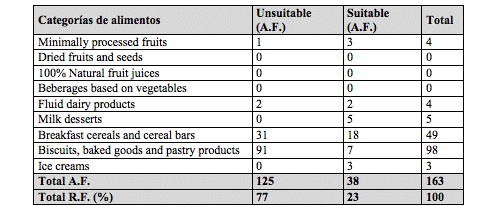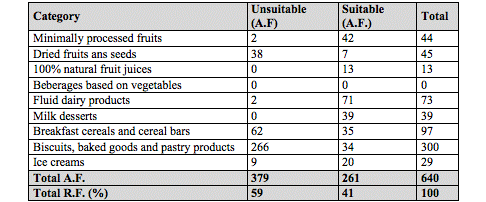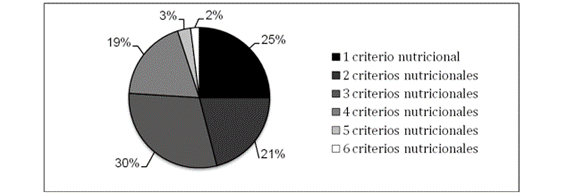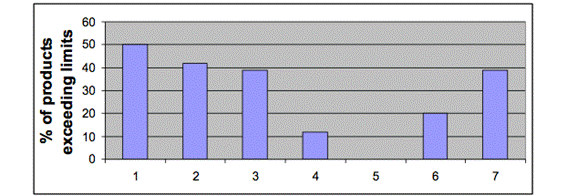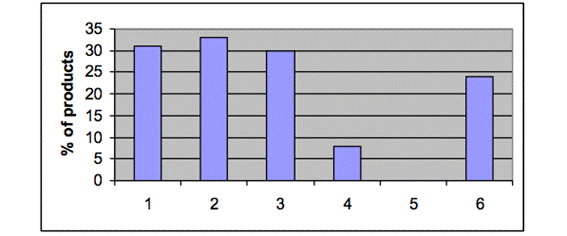Servicios Personalizados
Revista
Articulo
Links relacionados
Compartir
Enfermería: Cuidados Humanizados
versión impresa ISSN 1688-8375versión On-line ISSN 2393-6606
Enfermería (Montevideo) vol.7 no.2 Montevideo dic. 2018
https://doi.org/10.22235/ech.v7i2.1670
Artículos originales
Availability of foods and drinks that comply with Law 19,410 regarding school snacks in Montevideo supermarkets, in 2015
1Universidad Católica del Uruguay. Montevideo, Uruguay. carolinamutilvaa@gmail.com
Key words: Food supplies; Product Sale; School feeding; Healthy eating
Palabras clave: Oferta; Venta de productos; Merienda; Alimentación saludable.
Palavras chave: Oferta; Venda de produtos; Lanche; Alimentação saudável
Introduction
Non-communicable diseases (NCDs) have reached epidemic proportions and are the leading cause of death worldwide 1)(2. Unfortunately, Uruguay shares the same reality: NCDs are the main cause of morbidity and mortality in this country, being responsible for more than 60% of all deaths 3.
The main risk factors of NCDs are hypertension, hypercholesterolemia, low consumption of fruits and vegetables, excess weight or obesity, lack of physical activity, smoking and excessive consumption of alcohol 4)(2. One of the main characteristics of nutrition that scientific evidence relates to NCDs is the high consumption level of foods and/or beverages with low micronutrient content and high content of sugar, saturated fats, trans fatty acids and/or salt, such as sweet or salty snacks 5)(7.
The Food and Agriculture Organization of the United Nations (FAO) and the World Health Organization (WHO), assuming that the risk factors of these diseases begin in the early stages of life, have called for preventive actions in the childhood and youth tending to encourage healthy life habits and to highlight the role played by educational centers, identifying them as ideal areas for the promotion of community health 8)(10.
In this context, and as part of the political commitment to this public health problem, the uruguayan government approved Law 19140 in October 2013: Healthy Eating in Education Centers, Rules for its promotion11. This law establishes a list of food and drink groups that are nutritionally suitable to be offered in educational centers, and also the nutritional criteria to prepare them 12. The selection of these criteria was based on relevant scientific evidence, considering the nutritional recommendations for the Uruguayan population and the health risks associated with excessive consumption of calories and selected nutrients 13)(14. No studies were found evaluating the availability of food that are in accordance with the national regulations regarding school meals. The knowledge of which foods and beverages comply with this law is very important in order to know if schools and families can find them in supermarkets when planning the snacks of their children and adolescents. We considered that this is a useful contribution for the national organisms and authorities responsible for the elaboration of the healthy snack regulation, the food industry, the authorities of the educational centers and the educational community.
Therefore, the goal of this study is to evaluate the availability of food and beverages that can be included in the school snack according to Law 19140 in supermarkets of Montevideo, in 2015.
Methodology
It was a quantitative, observational, descriptive and transversal investigation. The data was collected during September, October and November 2015. The study was carried out in six supermarket chains in the city of Montevideo that sold food and beverages. The branches that were selected cover a large area of the city, including sectors of the population of different socioeconomic levels. These chains authorized the study, provided lists of products with the required information and allowed the visit to their premises in case that more information was required directly from the products on the shelves. The sources of information were: the lists of foods provided by the supermarkets or posted on their official websites, the products found in the shelves during the visits to selected locals, the technical specifications of Nutriguía (a Spanish clinical nutrition manual), and the nutritional labels of the products.
The study population was the total of the foods corresponding to Group 1: Natural or minimally processed foods and beverages recommended, and Group 3: Processed, packaged foods that comply with adequate limits regarding the caloric and nutrient content of Law 19140 , which must comply with the nutritional criteria established by the regulations for school snacks (Table 1).
Table 1: Foods that require their inclusion in the List of Recommended Foods and Drinks for educational centers
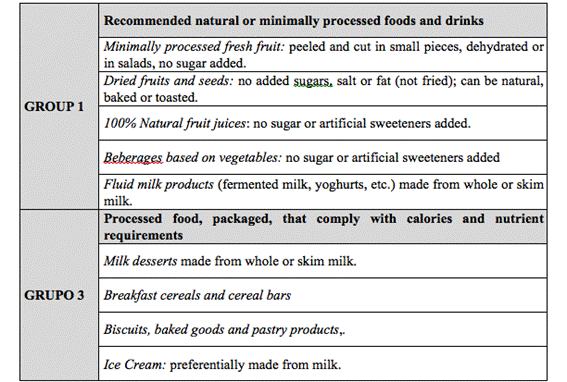
Source: Personal Collection (2017)
The sample calculation was not considered, because the heterogeneity of the elements would result in a sample of equal size of the population.
The products of Group 2: Preparations manufactured at the point of sale or homemade containing recommended ingredients in appropriate proportions were excluded from the study as they do not need to request admission to the List of Food and Drink Groups Recommended by this law 15. The products declared by the Ministry of Public Health (MSP) as not recommended for school meals were also not taken into account for this study 13.
The nutritional criteria of this law correspond to: maximum energy limits, total fats, saturated fats, transgenic fats, refined sugars and sodium that foods can have, either in percentage or per serving. The recommended servings in the regulations are 50 grams for solid food in general, 30 grams for nuts and seeds, and 200 ml for drinks 12)(14. In this study we only considered servings. Regarding trans fats, the upper limit considered was zero, as required by this law, for industrially added trans fats in all products except dairy (Fluid milk products, milk desserts and ice cream). In 100% Natural fruit juices and Beverages based on vegetables, products with non-caloric sweeteners were excluded as established in the regulations.
All presentations were considered in terms of net content of the products, except those of one liter (bags or bottles) for drinkable yoghurts.
The data was processed using Excel spreadsheets and the results were expressed in absolute frequency and percentual relative frequency for groups over 100 products and only in absolute frequency for groups under 100 products. When the amount of (refined) sugars was not declared in the nutritional labeling, "no data" was entered in the form. When the labeling declared the value “zero”, or "does not contain any", or "does not provide significant quantities of ..." for all the nutritional criteria evaluated, according to the current biosafety regulations, "0" was entered in the form 16.
The products that did not exceed the maximum limits of any of the six criteria evaluated were qualified as "Suitable", and those that exceeded at least one were qualified as "Unsuitable". The products in which the data about sugars was missing were declared as "Suitable" if they did not exceed any the other five criteria evaluated. This condition was taken into account when considering the results.
The anonymity of the information regarding the commercial brands of the products was preserved.
Results
The population studied included a total of 803 food products. 77% corresponded to Group 3 products of this law, and 23% to Group 1.
In Group 3, most of the products evaluated were Biscuits, baked goods and pastry products (64%) and Breakfast cereals and cereal bars (24%). In Biscuits, baked goods and pastry products, the highest percentages were for salted crackers, 32%, and sweet cookies, 27% (Tables 2 and 3 ).
Table 2: Quantity of evaluated products divided by Groups and categories according to Law 19140
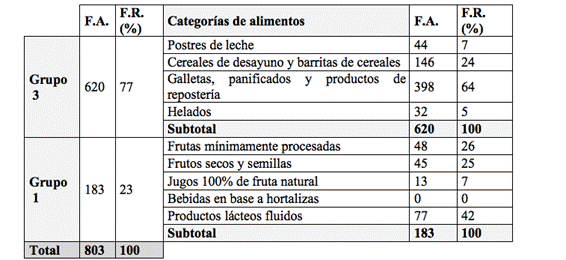
Source: Personal Collection (2017)
In Group 1, almost half of the products were Fluid dairy products (42%), and the categories Minimally processed fruits and Nuts and seeds each accounted for a quarter of the products evaluated. In the category Fluid dairy products, semi-solid products (for example, yoghurts with fruit) were on top with 61% (Tables 2, 3 ).
No products of the category Beverages based on vegetables were found in the supermarkets considered in the study.
In 80% of the products in this study all of the nutritional criteria required by Law 19140 could not be evaluated because the label did not declare the presence of refined sugars. In the remaining 20% the six nutritional criteria proposed by the law could be evaluated since the refined sugars content was included in the label. The results obtained are presented separately for these two subclasses.
Products in which all the nutritional information was available
In this subclass 60% of the products evaluated were Biscuits, baked goods and pastry products, and 30% were Breakfast cereals and cereal bars. No products of the type Nuts and seeds or 100% Natural fruit juices were found declaring the presence of refined sugars.
Table 3: Quantity and type of products found in supermarkets from each category of the law.
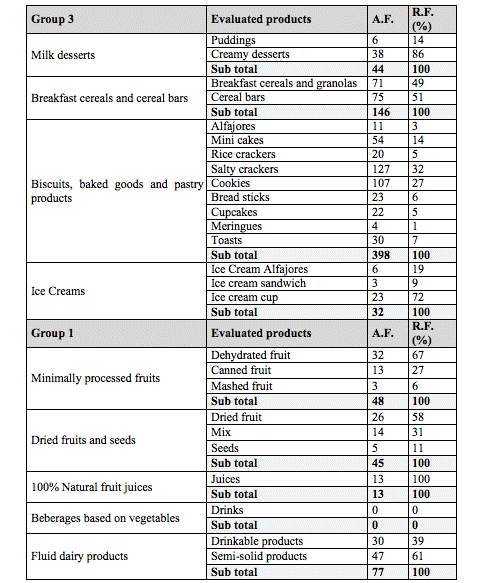
Source: Personal Collection (2017)
Unsuitable Products
77% of the products that had all the nutritional information did not comply with the law. In these Unsuitable products, Biscuits, baked goods and pastry products and also Breakfast cereals and cereal bars were predominant. Biscuits, baked goods and pastry products did not comply almost in the totality, and in Breakfast cereals and cereal bars almost in two thirds (Table 4).
30% of the Unsuitable ones exceeded the maximum limit of three of the nutritional criteria, 3% exceeded five of the criteria, and 2% exceeded the six criteria evaluated (Graph 1).
Of all the products in which all the nutritional information was available, 50% exceeded the limit of caloric intake, 42% exceeded the limit of total fats, 39% exceeded the limit of saturated fats, 39% that of sodium, 20% that of refined sugars, and 12% of the products exceeded the limit of industrial trans fats. No dairy product exceeded the limit of natural trans fats (Graph 2).
Suitable Products
23% of the products in which all the nutritional information was available comply with the law. In these Suitable products, Milk Desserts and Ice Cream predominated in proportion; in both categories the total of the products evaluated complied. These ice creams corresponded to diet products, reduced in calories and with 0% added sugar; milk desserts were products that declared to be sugar free (Table 4).
There were also products such as canned fruits, drinkable yoghurts, breakfast cereals, granola bars, cereal bars, sweet cookies, and one “alfajor” (a small jelly cookie sandwich). Of all these, only the drinkable yoghurts, the bars, some sweet cookies and the alfajor were offered in the portions recommended by law or in a smaller quantity.
Products that did not have all the nutritional information
In this subclass, products of all the categories proposed by the law were found (except Beverages based on vegetables). 47% of the products evaluated were Biscuits, baked goods and pastry products and 15% were Breakfast cereals and cereal bars.
Unsuitable Products The 59% of the products that did not have all the nutritional information do not conform to the nutritional criteria proposed by the law. In these Unsuitable products Biscuits, baked goods and pastry products, Nuts and seeds and Breakfast cereals and cereal bars were predominant, in that order. In the first and second group, almost all, and the third one, more than half (Table 5).
34% of Unsuitable products exceeded the maximum limit of one of the nutritional criteria, and 1% exceeded five of them, which in this subclass corresponds to all of the criteria evaluated (Graph 3).
Of the total of products that did not have all the nutritional information, 32% exceeded the limit of total fats, 31% exceeded the required caloric intake limit, 30% exceeded the saturated fats limit, 24% exceeded the sodium limit and 9% exceeded the industrial trans fats limit. No dairy product exceeded the limit of natural trans fats (Graph 4).
Suitable Products
41% of the products that did not have all the nutritional information comply with the law in five of the nutritional criteria (Table 5).
In this condition were Suitable all the 100% Natural fruit juices and the Milk desserts; and almost all of the Minimally processed Fruits and Fluid Milk Products as well as some products such as: mix of nuts and dried fruits, breakfast cereals, cereal bars, rice crackers, crackers, bread sticks, meringues, toasts and ice creams. Of all these Suitable products, only some dried fruits, some yoghurts, and cereal bars were offered in the portions recommended by law, or in smaller quantities.
Discussion
An exhaustive search of supermarket products was carried out in a large area of the city of Montevideo. We obtained a study population of 803 products, integrated by products corresponding to Groups 1 and 3 of Law 19140, and their categories. Within each category there were many products, leading to a fairly broad idea about the supply of supermarket products that can be included in school snacks.
In the category Beverages based on vegetables of Group 1, although it was included, no products were found in the shelves; this could indicate that they are not included in Uruguayan consumption habits, that are not produced, or that they are to be found in special health food stores and not in supermarkets. On the other hand there was a significant number of products culturally associated with the school snacks which could not be considered for this research since the Ministry of Public Health qualifies them as not recommended to be offered in educational centers 13. It is interesting to note that in 80% of the products studied it was not possible to evaluate all the nutritional criteria proposed by the law in order to determine if it could be included in the school snack list, since the nutritional labeling did not include the content of refined sugars. It is paradoxical that one of the criteria considered key in the prevention and/or control of NCDs is not considered mandatory in the declaration of nutritional labeling according to the current bromatological regulations, therefore not warning consumers.
In other countries such as Chile, that has been working actively to contribute to the reduction of the epidemic of overweight and obesity in the population, the information about sugar content is mandatory in the nutritional labeling of packaged foods 17. In Chile the law of frontal labeling of foods was implemented in 2016, whereby products that have a high content of sugars (among other things) must have a prominent label showing that condition 17. Currently the government of our country, and following the good experience of Chile, has decreed and sent to Parliament the bill that establishes the front labeling of packaged foods, that is, the incorporation of visible labels warning about excess sugar, saturated fats and salt contents. In this way the consumer may have information about the high amount of these nutrients harmful to their health 18. In the two subclasses the predominant products were those belonging to the categories Biscuits, baked goods and pastry products and Breakfast cereals and cereal bars, in that order. In both categories there are foods culturally associated with snack time.
Products in which all the nutritional information was available
77% of these products do not comply with the provisions of the law. This high value is a limitation when opting for recommended foods for school snacks, both to offer them in educational institutions, and for families to buy them.
In proportion, the predominant Unsuitable products were Biscuits, baked goods and pastry products and then Breakfast cereals and cereal bars. The first ones include products such as puddings, rice crackers, crackers, cookies, bread sticks, muffins and toasts. Almost all of the products were Unsuitable, so they should not be the first option when choosing products for the school snack. The main nutritional criterion exceeded by these products was the caloric intake and then the total fats, saturated fats and sodium. In the second category, two thirds were Unsuitable, so care is required when choosing them. In these products, the main nutritional criteria exceeded were refined sugars and sodium.
These dietary aspects are related to NCDs such as overweight/obesity, cardiovascular disease, hypertension and type 2 diabetes 2)(7)(1)(9)(20)(21. That is, children and adolescents would be exposed to these factors and their possible consequences in the short, medium and/or long term. This is also a useful information for the industry, knowing what aspect of the products should be modified to comply with the regulations.
Some aspects that the industry could consider would be: working on the modification of the quality of the fats used, decreasing the contents of saturated fats and increasing the mono and polyunsaturated fats, using vegetable oils instead of animal fat; decrease the amount of total fats, using the necessary ingredients in its low or reduced fat versions, such as skim milk instead of whole milk; decrease the total caloric intake from fats and other macronutrients such as sugars, which can be replaced by non-nutritive sweeteners in small amounts. In addition, the increase in dietary fiber of the products can be taken into account to take advantage of their physiological effects with respect to the reduction of absorption of sugars, fat and cholesterol, and the reduction of the total sodium content.
The nutritional criterion least exceeded was that of industrial trans fats (in less than one eighth of the products). This seems to be a positive aspect to highlight, but it is necessary to consider that according to the normative, values smaller or equal to 0,2 g per portion can be declared as "0" or "it does not contain…", and that the declaration of the list of ingredients of the products was not taken into account in order to determine whether or not trans fats were present.
On the other hand, in the Unsuitable products the number of products was counted according to the number of nutritional criteria that exceeded the limit required by law, understanding that a product that exceeds just one of the criteria is not as bad as a product that exceeds more than one or, to the extreme, all the criteria. This means that a product that exceeds only one criterion is more feasible to be modified by the industry to comply with the law than a product that exceeds more than one, or all. Fortunately only 3% and 2% of the products exceeded the required limit of five and six nutritional criteria respectively but almost two thirds of the Unsuitable products exceeded the limit of three nutritional criteria (half of the criteria required by law). This high proportion of products in place that deviate from what is required in half of the criteria shows a long road to travel for the food industry, if they seek to adapt to what is recommended by law for primary and high school children.
Only 23% of the products evaluated on the market comply with the provisions of the law; that is, less than a quarter can be recommended for school meals. The following questions arise: should the law be less demanding in terms of the maximum limits required, considering that it is aimed at the entire primary school and high school population, regardless of their nutritional status?, or should the food industry modify the nutritional composition of most of its products, or at least those that are culturally chosen for snack time within the educational centers?
At the time of choosing the focus should be placed, according to the Suitable product list, in: canned fruits, drinkable yoghurts, milk desserts (creams), breakfast cereals, granolas, cereal bars, cookies, alfajores and diet or reduced in calories ice cream. However, of all of them, only drinkable yoghurts, bars, some sweet cookies and the only suitable alfajor found were offered in the quantities recommended by law or smaller. The rest was presented in large quantities, which means that in order to be offered in the school or to be taken from home, a previous fractioning and a suitable new packaging are needed. For some products, such as breakfast cereals or sweet cookies, fractioning and re-packaging would not be complicated; but for others, such as milk and ice cream desserts, it could be more complex. In other words, if to start with there was already a small number of Suitable products available, when taking into account the portion in which those foods should be consumed during school recess then we get an even smaller number of products that can be consumed as a snack.
Products that did not have all the nutritional information
59% of these products do not comply with the provisions of the law. This high percentage (which could be higher if refined sugars could be evaluated) is also a limitation when choosing recommended foods for snacking.
The Unsuitable products that predominated were Biscuits, baked goods and pastry products, Nuts and seeds and Breakfast cereals and cereal bars. In the first two categories mentioned almost all of them were Unsuitable, so they should not be the first option when choosing products for school meals. In the third category, more than half were Unsuitable, requiring also a careful choice.
In Biscuits, baked goods and pastry products the main nutritional criterion exceeded was the caloric intake, then the saturated fats and sodium. In Nuts and seeds, the main criterion exceeded was that of total fats in all the products. In Breakfast cereals and cereal bars, the main criteria exceeded were the caloric intake and total fat. Again we can highlight here the relationship of these dietary factors with the NCDs already mentioned, so it would be important to adjust the maximum content of these nutrients in the products present in the supermarkets in Montevideo. Possible modifications to be made by the industry have already been discussed in the previous section. In this subclass also the nutritional criterion less exceeded was that of industrial trans fats, but the pertinent considerations regarding this point were already mentioned before. Fortunately, just 1% of the products exceeded the required limit of five nutritional criteria (all the criteria in this subpopulation). Then, almost a third exceeded the limit of three nutritional criteria. The industry has an important job to do in terms of the modification of these products in order to expand the offer according to what is proposed for the school snack.
41% of the products evaluated on the market comply with the provisions of the law (if hypothetically they do not exceed the limit of refined sugars); that is, less than half of the products could be recommended for a school snack. Although this percentage is almost twice the percentage found for the other subclass, it must be taken into account that it is low in all cases, and that, as explained, it would be necessary to evaluate the mentioned sugars.
When choosing among the appropriate products the focus should be placed in: 100% Natural fruit juices, Milk desserts, Minimally processed fruits, and Fluid dairy products. However, of all of them very few were presented in the recommended portions for the school snack or in smaller quantity. They have to be fractioned and repacked.
No studies were found on the evaluation of the availability of food and beverages that comply with the national regulations regarding school meals, nor relevant international studies in countries of Latin America. For this reason, the results presented could not be compared with other investigations.
Conclusions
In 80% of the population studied it was not possible to evaluate all the nutritional criteria proposed by Law 19140 to determine if a product could be included in the school snack, because the mandatory declaration of nutritional labeling does not include refined sugars. It would be important to consider the modification of the mandatory nutritional labeling so that it includes contents of refined sugars, a dietary factor strongly related to several of the most prevalent NCDs. In the two subclasses, the predominant products were, in the first place, those belonging to the categories Biscuits, baked goods and pastry products, and secondly. Breakfast cereals and cereal bars. This can be taken into account to innovate in the development of other types of healthy products that comply with the law, thus expanding the variety of products available for the school snack.
In both subclasses of the present investigation the proportion of Unsuitable products exceeded by far the Suitable products. This high proportion of Unsuitable products supposes a limitation at the time of opting for foods recommended for school snack. It is obvious that there is a need to work hard with the industry to develop new healthy products that comply with the regulations, or to modify existing ones so that they meet the nutritional criteria proposed by the law. The industry could consider making changes to the quality of the fats (decreasing saturated fats and increasing mono and polyunsaturated fats) and using vegetable oils instead of animal fat. Also decreasing the contribution of total fats, using the necessary ingredients in its low fat versions such as skim milk instead of whole milk; and in decreasing the total caloric intake as a consequence. The decrease in total sugar and sodium intake can also be managed. In addition, the increase in dietary fiber of the products can be taken into account in order to take advantage of their physiological effects with respect to the reduction of absorption of sugars, fat and cholesterol.
The main nutritional criteria exceeded by the Unsuitable products, in both subclasses studied were the caloric intake, total fats and saturated fats, and then sodium. Refined sugars and industrial trans fats were also exceeded, although in a smaller number of products. This information would facilitate the work of the industry since it is useful to focus on those nutrients when modifying existing products.
With regard to the quantity offered, in grams or milliliters it was found that few of the Suitable products are presented in the amounts recommended for the school snack; they need to be fractioned and repackaged. This means that the industry should also work on this aspect, modifying the presentations of existing products and offering them in the portions recommended by law.
After carrying out this research, it can be concluded that there are few adequate options in the market for school meals, as recommended by Law 19140: Healthy Eating in Education Centers, Rules for their promotion.
Finally we want to emphasize that making the school snack a healthy intake, although it does not solve the problem of overweight/obesity of children and adolescents, is a key tool that contributes to its solution. It is necessary, as declared by PAHO and WHO, a response and multisectoral commitment, by governments and many sectors of society, both public and private, to curb or control the NCD epidemic.
REFERENCES
1. Organización Mundial de la Salud. Ginebra: OMS; 2011 . Informe sobre la situación mundial de las enfermedades no trasmisibles 2010: Resumen de orientación . Disponible en: http://www.who.int/nmh/publications/ncd_report_summary_es.pdf [ Links ]
2. Organización Mundial de la Salud. Dieta, nutrición y prevención de enfermedades crónicas. Informe de un Grupo Científico de la OMS. Ginebra: OMS; 2003. Serie de Informes Técnicos: 916. Disponible en: http://www.who.int/nutrition/publications/obesity/WHO_TRS_916_spa.pdf?ua=1 [ Links ]
3. Ministerio de Salud Pública. . Montevideo: MSP; 2006 . 1º Encuesta Nacional de Factores de Riesgo de Enfermedades Crónicas No Transmisibles. Disponible en: http://www.msp.gub.uy/sites/default/files/archivos_adjuntos/1er_enfrecnt_2006_1.pdf [ Links ]
4. Organización Mundial de la Salud. Ginebra: OMS; . Estrategia mundial sobre régimen alimentario, actividad física y salud: meta general. Disponible en: http://www.who.int/dietphysicalactivity/strategy/eb11344/strategy_spanish_web.pdf [ Links ]
5. Organización Panamericana de la Salud Washington D.C.: OPS; 2014 . Plan de acción para la prevención del sobrepeso y obesidad en la niñez y la adolescencia. Disponible en: http://www.paho.org/hq/index.php?option=com_docman&task=doc_view&Itemid=270&gid=28899&lang=es [ Links ]
7. Organización Mundial de la Salud. Ginebra: OMS; . Comisión para acabar con la obesidad infantil: Informe de la Comisión para acabar con la obesidad infantil. Disponible en: http://www.who.int/end-childhood-obesity/publications/echo-report/es/ [ Links ]
8. Olivares S, Yáñez R, Díaz N. Publicidad de alimentos y conductas alimentarias en escolares de 5° a 8° básico. Rev. chil. nutr.. 2003 Abr ; 30 (1). Disponible en: http://dx.doi.org/10.4067/S0717-75182003000100005. [ Links ]
9. Organización Mundial de la Salud. Ginebra: OMS; . Informe sobre la situación mundial de las enfermedades no transmisibles 2014. Disponible en: http://www.who.int/nmh/publications/ncd-status-report-2014/es/ [ Links ]
10. Unión Internacional de promoción de la salud y educación para la salud St. Denis: UIPES; 2009 . Generar escuelas promotoras de salud: pautas para promover la salud en la escuela. Disponible en: http://www.iuhpe.org/images/PUBLICATIONS/THEMATIC/HPS/HPSGuidelines_SP.pdf [ Links ]
11. Alimentación saludable en los centros de enseñanza. Normas para su promoción. Ley 19.140 de 11 de octubre. Boletín Diario Oficial, nº 28830, (28 - 10 - 2013). [ Links ]
12. Criterios nutricionales de referencia para el listado de alimentos recomendados. Ministerio de Salud Pública, Ordenanza Ministerial nº 116/104, 11 de marzo 2014 [ Links ]
13. Ministerio de Salud Pública. Montevideo: MSP; 2014. Recomendaciones de buenas prácticas para la implementación de cantinas y quioscos saludables en las instituciones educativas. Disponible en: http://www.msp.gub.uy/sites/default/files/archivos_adjuntos/Manual%20de%20recomendaciones%20de%20Buenas%20Practicas.pdf [ Links ]
14. Ministerio de Salud Pública. Montevideo: MSP; 2014. Lineamientos para la venta y publicidad de alimentos en centros de enseñanza primaria y secundaria públicos y privados del país. Documento técnico. Disponible en: http://www.msp.gub.uy/sites/default/files/archivos_adjuntos/Lineamientos_nutricionales_para_%20la_venta_%20de_%20alimentos_en_centros_educativos_v2.pdf [ Links ]
15. Escuelas promotoras de salud. Montevideo: MSP; . Preguntas frecuentes. Disponible en: http://escpromotorasdesalud.weebly.com/uploads/1/3/9/4/13940309/pregunt as _frecuentes_.pdf [ Links ]
16. Aprobación de resoluciones GMC nº 26/03, 44/03, 46/03 y 47/03 Mercosur. Reglamento Bromatológico Nacional. Decreto nº 117/006, 27 marzo 2014. [ Links ]
17. Ministerio de Salud . Santiago: Minsal; . Ley de Alimentos Manual Etiquetado nutricional. Disponible en: http://www.minsal.cl/ley-de-alimentos-manual-etiquetado-nutricional/ [ Links ]
18. Ministerio de Salud Pública. Montevideo: MSP; . Poder Ejecutivo emitió decreto y proyecto de ley sobre rotulado frontal de alimentos envasados. Disponible en: http://www.msp.gub.uy/noticia/poder-ejecutivo-emiti%C3%B3-decreto-y- proyecto-de-ley-sobre-rotulado-frontal-de-alimentos [ Links ]
19. Sociedad Uruguaya de Aterosclerosis, Sociedad Uruguaya de Cardiología. 1er. Consenso Nacional de Aterosclerosis: Recomendaciones para la prevención y el tratamiento de la Aterosclerosis. Montevideo: Sociedad Uruguaya de Aterosclerosis; 2004. [ Links ]
20. Sociedad Uruguaya de Hipertensión Arterial. Hipertensión Arterial: 3er. Consenso Uruguayo. Montevideo: S.U.H.A.; 2005 [ Links ]
21. Organización Mundial de la Salud. Ginebra: OMS; . Biblioteca electrónica de documentación científica sobre medidas nutricionales: Reducir la ingesta de sodio para reducir la tensión arterial y el riesgo de enfermedades cardiovasculares en adultos . Disponible en: http://www.who.int/elena/titles/sodium_cvd_adults/es/ [ Links ]
Received: April 01, 2018; Accepted: July 05, 2018











 texto en
texto en 

